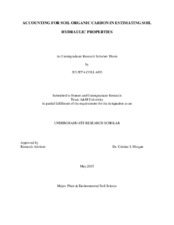| dc.creator | Collazo, Julieta | |
| dc.date.accessioned | 2017-10-10T20:26:39Z | |
| dc.date.available | 2017-10-10T20:26:39Z | |
| dc.date.created | 2015-05 | |
| dc.date.issued | 2014-09-22 | |
| dc.date.submitted | May 2015 | |
| dc.identifier.uri | https://hdl.handle.net/1969.1/164435 | |
| dc.description.abstract | Soil scientists and agronomists know that increases in soil organic matter change the way that soil and water interact. Soil high in organic matter develop stronger aggregation and soil structure resulting in increased porosity, water holding capacity, and infiltration rates. Changes in land use and climate alter soil organic matter and subsequently soil hydraulic properties. However, land surface and hydrology models generally use soil hydraulic properties based only on soil texture without information on soil organic matter. The goal for this project is to improve available soil information for hydrology modeling by adding organic matter content into prediction functions of soil hydraulic properties, therefore making more representative predictions of how soils interact with water. Porosity, hydraulic conductivity and soil water contents at field capacity (ϴFC)and permanent wilting point (ϴWP)were estimated using multiple linear regression that incorporate measurements of soil texture and organic matter for A (surface) horizons. Data on soils in the National Cooperative Soil Characterization Database were used to create these functions for Texas and neighboring states and then compared to existing pedotransfer functions. The results agree with the literature that soil organic matter is a statistically significant component, along with texture, in predicting porosity, field capacity, and permanent wilting point; however, the change in predicted values is not functionally different except when predicting porosity. Because newly predicted porosity values were different, estimates of saturated hydraulic conductivity were also worth recalculating using organic matter. The results are attributed to the way field capacity is measured on soil clods rather than soil volumes that include inter-pedal pores. Though we know that soil organic matter has a strong link to soil structure, the databases available do not contain the type of information needed to fully represent the relationship between soil organic matter, soil structure, and soil water relations. | en |
| dc.format.mimetype | application/pdf | |
| dc.subject | Soil Science, Hydraulic Properties, Soil Organic Matter, Pedotransfer Functions | en |
| dc.title | ACCOUNTING FOR SOIL ORGANIC CARBON IN ESTIMATING SOIL HYDRAULIC PROPERTIES | en |
| dc.type | Thesis | en |
| thesis.degree.department | Agricultural Leadership, Education, and Communications | en |
| thesis.degree.discipline | Agricultural Science | en |
| thesis.degree.grantor | Undergraduate Research Scholars Program | en |
| dc.contributor.committeeMember | Morgan, Cristine L | |
| dc.type.material | text | en |
| dc.date.updated | 2017-10-10T20:26:40Z | |


